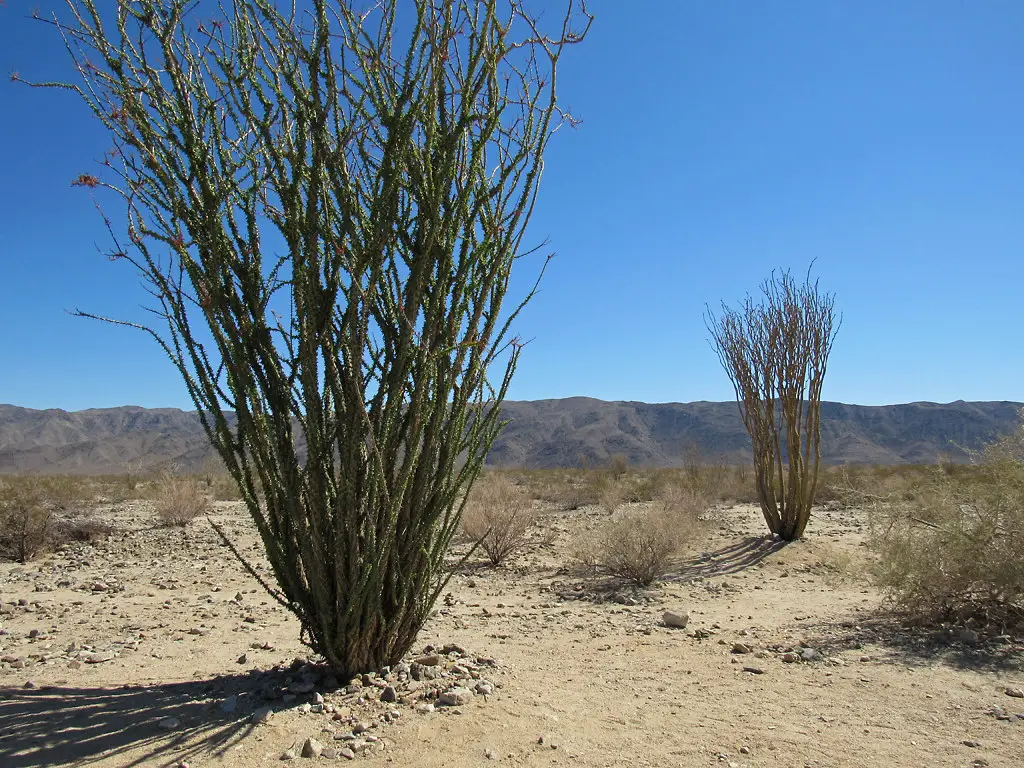The Ocotillo plant, known for its slender, spiny branches that shoot upward, is a distinctive and captivating presence in arid landscapes. Often mistaken for a cactus, Ocotillo is actually a desert shrub that is native to the southwestern United States and northern Mexico. Its long, thorny stems are covered with small leaves that appear after rainfall and beautiful red or orange tubular flowers that bloom in spring.
Ocotillo’s unique appearance, drought tolerance, and adaptation to harsh desert environments make it a favorite in xeriscaping. It is not just a decorative plant; Native American tribes have utilized Ocotillo for centuries for medicinal purposes, fencing, and shelter construction.
With its strong visual appeal and low-maintenance requirements, Ocotillo is an excellent addition to rock gardens, desert landscapes, and southwestern-themed designs. Its ability to thrive in extreme conditions is a testament to its resilience and a symbol of beauty amid adversity.
| Attribute | Details |
|---|---|
| Common Names | Ocotillo, Coachwhip, Jacob’s Staff, Vine Cactus |
| Botanical Name | Fouquieria splendens |
| Family | Fouquieriaceae |
| Plant Type | Deciduous Shrub |
| Mature Size | 10-30 feet tall, 15 feet wide |
| Sun Exposure | Full sun |
| Soil Type | Well-drained, sandy or rocky soil |
| Hardiness Zones | 8-11 |
| Native Area | Southwestern United States, Northern Mexico |
Ocotillo Care
Ocotillo is well-suited to desert gardens and requires minimal care. Being native to arid regions, it thrives in dry, hot conditions and is highly drought-tolerant. Over-watering or planting in an area with poor drainage can lead to root rot, so it’s essential to provide well-draining soil.
Fertilizing is generally unnecessary for Ocotillo. If planted in native soil, it usually receives all the nutrients it needs from the surrounding environment. The best way to care for Ocotillo is to replicate its natural habitat as closely as possible, avoiding over-watering and providing plenty of sunlight.
Light Requirement for Ocotillo
Ocotillo thrives in full sun and should be planted in an area that receives sunlight throughout the day. A lack of sunlight may cause the plant to become leggy and lose its distinctive form.
Soil Requirements for Ocotillo
Ocotillo prefers well-drained, sandy, or rocky soil. Soil that retains too much moisture can lead to root rot, so it’s important to avoid heavy clay soils or areas where water collects.
Water Requirements for Ocotillo
Ocotillo is extremely drought-tolerant and can survive long periods without water. However, occasional deep watering, especially during the hot summer months, can encourage growth and flowering. Be careful not to overwater, as this can lead to root problems.
Temperature and Humidity
Ocotillo is adapted to hot, dry climates and can withstand temperatures well above 100°F. It is frost-tolerant down to around 20°F, but prolonged exposure to freezing temperatures can damage the plant.
Fertilizer
Fertilizing Ocotillo is usually unnecessary. If planted in native soil, it should receive all the nutrients it needs naturally. Adding fertilizer can lead to excessive growth and decrease drought tolerance.
Pruning Ocotillo
Pruning is generally not required for Ocotillo. If desired, dead or damaged stems can be removed to maintain the plant’s appearance. Pruning should be done carefully to avoid injury from the sharp thorns.
Propagating Ocotillo
Ocotillo can be propagated from cuttings. Take a cutting from a healthy stem, allow it to dry for a few days, and then plant it in well-draining soil. Water sparingly until roots are established.
How To Grow Ocotillo From Seed
Growing Ocotillo from seed is possible but challenging. Seeds should be collected in the fall and stratified for at least a month. They can then be planted in well-draining soil and kept warm until germination.
Common Pests & Plant Diseases
Aphids
Small insects that can be controlled with insecticidal soap or neem oil.
Root Rot
Caused by over-watering or poor drainage. Adjust watering practices and ensure proper soil conditions.
Common Problems With Ocotillo
Legginess
A result of inadequate sunlight. Ensure the plant receives full sun.
Lack of Blooming
May result from overwatering or poor soil conditions. Adjust watering and soil practices as needed.
Pro Tips
- Plant Ocotillo in a location that mimics its native desert habitat.
- Use gloves and tools when handling Ocotillo to avoid injury from thorns.
- Provide occasional deep watering during summer but avoid over-watering.



